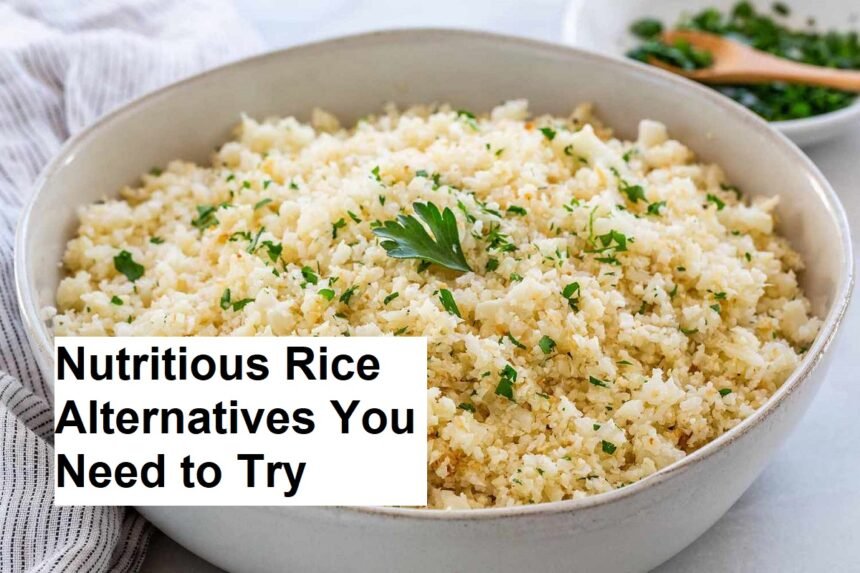Introduction
Rice is a staple food for millions of people worldwide, especially in Asian countries. It is a primary source of carbohydrates, providing energy and supporting daily activities. However, for various reasons—including health concerns, dietary restrictions, or simply seeking variety—many individuals look for healthier or alternative options to replace rice in their meals. Fortunately, there are numerous nutritious substitutions that can be just as healthy and delicious, offering diverse flavors and nutritional benefits.
1. Quinoa
Often hailed as a superfood, quinoa is a complete protein that contains all nine essential amino acids. It is also rich in fiber, vitamins, and minerals such as magnesium, iron, and B vitamins. Quinoa is naturally gluten-free and has a slightly nutty flavor that pairs well with vegetables, meats, and sauces. Its fluffy texture when cooked makes it a perfect rice substitute in salads, bowls, or as a side dish.
2. Cauliflower Rice
Cauliflower rice has gained popularity as a low-carb, low-calorie alternative to traditional rice. Made by pulsing cauliflower florets in a food processor until they resemble rice grains, this vegetable-based option retains many nutrients, including vitamin C and fiber. It’s versatile, easily flavored with herbs or spices, and can be sautéed, steamed, or eaten raw. Cauliflower rice is particularly suitable for those following keto or paleo diets.
3. Broccoli Rice
Similar to cauliflower rice, broccoli rice is prepared by pulsing broccoli stems and florets into small pieces. It is low in calories and rich in vitamins C and K, along with fiber. It offers a slightly different taste and texture from cauliflower rice, adding variety to your meals. Broccoli rice works well as a base for stir-fries, salads, or mixed with other vegetables.
4. Barley
Barley is a hearty whole grain with a chewy texture and nutty flavor. It is an excellent source of dietary fiber, including beta-glucan, which supports heart health by reducing cholesterol levels. Barley also provides vitamins and minerals like selenium and magnesium. Used in soups, salads, or as a side dish, barley adds a nutritious twist that can replace rice in many recipes.
5. Shirataki Noodles
Made from the konjac plant, shirataki noodles are a low-calorie, gluten-free alternative to rice and traditional pasta. They are high in soluble fiber, which aids digestion and promotes feeling full longer. While they are typically used in noodle dishes, they can also be broken into smaller pieces and incorporated into rice-based recipes, making them a versatile diet-friendly option.
6. Sweet Potatoes
Sweet potatoes are nutrient-dense root vegetables rich in vitamins A and C, fiber, and antioxidants. They provide a natural sweetness and a creamy texture when cooked. Sweet potatoes can be mashed, roasted, or sliced into small cubes as a rice alternative. They’re particularly good for increasing the nutritional value of meals and enhancing flavor variety.
7. Bulgur Wheat
Bulgur is made from cracked wheat that has been parboiled, dried, and ground. It has a chewy texture and a nutty flavor, making it a healthy substitute for rice. Rich in fiber, protein, and iron, bulgur is often used in salads like tabbouleh or as a side dish. Its quick cooking time makes it a convenient healthy option.
8. Lentils
Though not a direct rice substitute, lentils are an excellent source of protein, fiber, and various nutrients. They can be cooked and used as a base for dishes typically served with rice, or mixed with grains for added texture and nutrition. Lentils support digestive health and help maintain stable blood sugar levels.
Conclusion
Choosing healthy alternatives to rice can diversify your diet and boost nutritional intake. Whether you prefer vegetables like cauliflower or broccoli, grains like barley or bulgur, or other options like quinoa and sweet potatoes, each offers unique health benefits. Incorporating these substitutes into your meals not only adds variety but also promotes a more balanced and nutritious diet.
Remember, the key is to select options that fit your dietary needs and taste preferences. Experimenting with different alternatives can make your meals more exciting and healthful.












